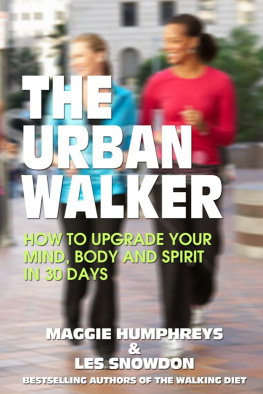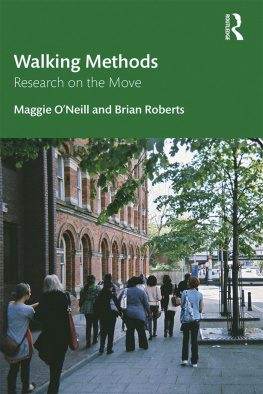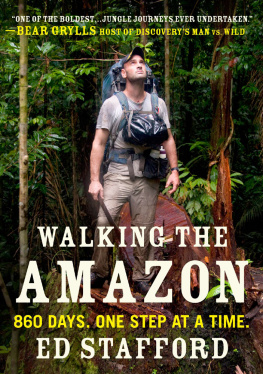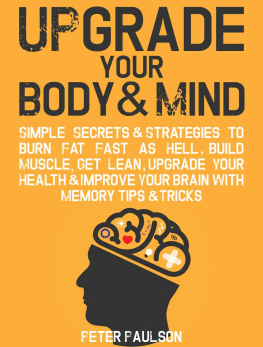Maggie Humphreys and Les Snowdon have been enthusiastic walkers since childhood. Following the worldwide success of their first book The Walking Diet they have had several other books published including Fitness Walking and Walk Slim and have been at the forefront of initiatives to promote the benefits of walking for fitness and healthy living. They have been interviewed and featured more than 200 times in the press, on radio and on television. They believe that walking is the best exercise because it is accessible to just about anyone and anyone can begin getting fit and healthy simply by walking out of their own front door.
See www.WalkWalk.co.uk for more about Maggie and Les.
THE URBAN WALKER
How to Upgrade Your Mind, Body
and Spirit in 30 Days
Maggie Humphreys & Les Snowdon
Copyright MAGGIE HUMPHREYS
and LES SNOWDON 2013
ISBN 978-1-78301-242-8
All rights reserved. This book may not be reproduced in any form, in whole or in part, without written permission from the author.
Before commencing a fitness programme, check with your doctor first if you are unfit, sedentary, overweight, obese, pregnant, or have any medical problem, diagnosed or otherwise, that will affect your ability to exercise.
CONTENTS
Foreword
A slow sort of country! said the Queen. Now here, you see, it takes all the running you can do, to keep in one place. If you want to get somewhere else, you must run at least twice as fast as that!
Lewis Carroll in Through the Looking Glass reflected the problems of many of us in contemporary society. The pace and stress of life is more frenetic than ever before, with people not spending enough time reflecting on their lifestyle exercise, eating the right foods, balancing home and work, and looking after their own and their familys health and well-being. Stress is now as much a part of our modern vocabulary as smartphones, laptops, fast food and email. In this book, Maggie Humphreys and Les Snowdon help you to think through your day-to-day lifestyle and motivate you to reflect on the current rhythm of your life how exercise, diet, and relaxation techniques can help you take control of your life and turn stress into motivation and inspiration.
Professor Cary L Cooper CBE
Distinguished Professor of Organizational Psychology and Health
Lancaster University Management School
MAGGIES STORY
Walking takes me apart; walking puts me back together again. I walk, therefore I am.
This book is about urban walking and how it can seriously improve your fitness, health and wellbeing and help you cope with the daily stress of life. It is a health warning, a wake up call, to step out into the open air, take a deep breath and reconnect with your mind, body and spirit.
People have always walked, ever since Lucy climbed down from her tree in the Great Rift Valley in Africa 3.3 million years ago and began walking upright on two legs. And for much of that time until around 40 years ago, most people on the planet got around in their daily lives by walking about their business. But then it all changed as increasing numbers of people moved to cities to find work and an agricultural-based economy developed into a mass industrial, technological and service economy.
The majority of the worlds population now lives in a city, and this proportion continues to grow year by year. When Queen Victoria died in 1901, 20 per cent of people across the world lived in an urban area. It took until 1990 for this to double to around 40 per cent of the global population living in a city, but as of 2010, according to the World Health Organisation, more than 50 per cent of all people now live in an urban area, by 2030 this will increase to 60 per cent and by 2050 to 70 per cent.
Whats wrong with that?
In itself, nothing, but increasing urbanisation, whilst providing work and a higher standard of living for most people, has also brought in its wake health and wellbeing problems such as stress, heart disease, cancer, obesity and a host of related diseases as people have tended to become more sedentary. Sedentary, inactive and stressed out with the pace of life and technological and social change, homo ambulans (the man who walks) has transformed himself into homo sedens (the man who sits) and is carried around. More than 100 years ago the writer Ralph Waldo Emerson foresaw this when he said: The civilised man has built a coach but has lost the use of his feet.
Of course, in one sense you could say that we all begin our lives literally by being carried around in the wheelchair of the womb. In fact it would be true to say that many of us spend most of our lives being carried around. As we leave the womb, enter the world and grow, and get over the initial wonder of walking, we change our pre-natal wheelchair for a series of substitute wheelchairs bicycles, motor cycles, cars, taxis, buses, trains, aeroplanes and chairs (in houses, schools, offices; anywhere where people gather and sit).
For this is now the age of homo sedens Generation Sedens. For increasing numbers of inactive, overweight, obese people all over the world, Generation Sedens has its default setting stuck on inactive. In all ages prior to our modern scientific age, people had a more physical and active lifestyle they spent more time on their feet than they did sitting. But all that began to change as more and more people became inactive, and today you only have to look around you to see the results of this.
Imagine for a moment the start of a typical school day throughout the Western world during term time. Stepping out of the door in the cool, morning air, we are immediately confronted by what is called the school run. A misnomer really, for many children hardly ever run, they dont even walk. Many of them are carried back and forth to school each day, carried around like eighteenth century aristocrats in motorised sedan chairs by their parents. All part of the modern toxic, subprime, sedentary, stressed out world which we all inhabit.
How do I know this?
As a teacher, for more than thirty years I have noticed children of all ages become more inactive and sedentary and much of this can be observed right outside the school gate. As a new academic day springs to life, the air outside many schools is thick with petrol and diesel fumes belching, spewing and spluttering their detritus into the cool morning air, like a scene from a Lowry painting. Gas guzzling, co2 curdling people-carriers, UPVs, 4 x 4s and other assorted vehicles (many of which would not be out of place on a war zone battlefield) pass by like a funeral cortge carrying tired, bleary-eyed, unfit, inactive kids for their daily dose of the governments latest curriculum, educating them to become producers and consumers in the vast globalised production line we call life. A scene from a typical day in thousands upon thousands of schools across the global village we all live in.
Of course, it would be unfair to suggest everyone gets to school this way many parents walk with their children to school and many older children walk or cycle to school but you get the picture!
Now this is only school kids we are talking about. With at least 50 per cent of people in the world now living in cities, increasing numbers of workers commute to work either in cars, on public and private transport or some other way that involves minimum physical activity. Many then spend their days sitting in offices affording little opportunity to become active.
OK this is all fine but what has this got to do with urban walking? And why urban walking? Why do we need to become urban walkers? Whats wrong with country walking, rambling, hiking or some other form of regular walking exercise.
Next page









